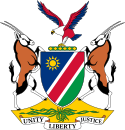

 |
|---|
|
|
|
|
|
|
|
|
|
|
The government of Namibia consists of the executive, the legislative and the judiciary branches. The Cabinet is the executive organ of government, implementing the laws of the country. It consists of the president, the prime minister and his deputy, as well as the ministers of the Cabinet of Namibia. The legislative organs of government are the National Council and the National Assembly. They make the laws of the country. The judiciary organs of government are the courts. The highest court of Namibia is the Supreme Court. There are also the high courts and lower courts.[1]
The Namibian government is partly centralised and partly regional. In the executive branch, central government consists of ministries, offices and agencies, whereas regional government consists of regional councils, and constituencies within these.[1] The legislation is centralised in the lower house (National Assembly), and regional in the upper house (National Council).[2] The judiciary is centralised in the Supreme Court, whereas high courts and lower courts are distributed all over the country.
The central executive branch of government consists of offices, ministries, and agencies. The offices of central government are:[3]
As of 2020[update] there are 19 stand-alone ministries in Namibia.[3] The Ministry of Gender Equality retained its minister in the 2020 downsizing of cabinet but falls under the Office of the President above.[4]
The agencies of the central government are:[3]
The Namibian state runs and owns a number of companies such as Transnamib and NamPost, most of which need frequent financial assistance to stay afloat.[5][6]
There is a number of agencies and authorities established by acts of Parliament that can be considered government organisations:
Alongside ordinary governance, Namibia also has a parallel system of traditional leadership. Only people of tribes recognised by the state, living in their traditional areas, are subject to this type of government which covers land allocation, traditional marriage, and lower courts. There are 51 recognised traditional authorities and a further 40 pending applications.[10]